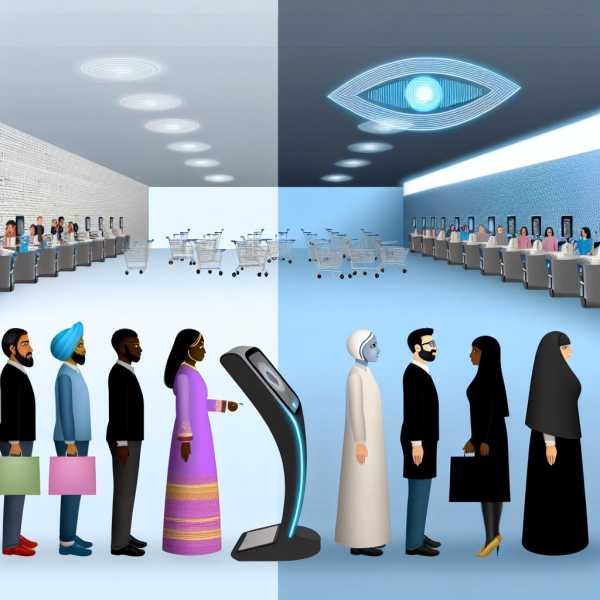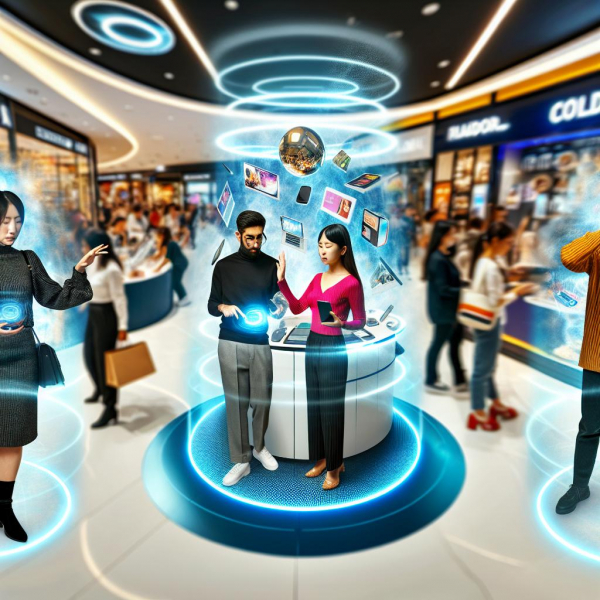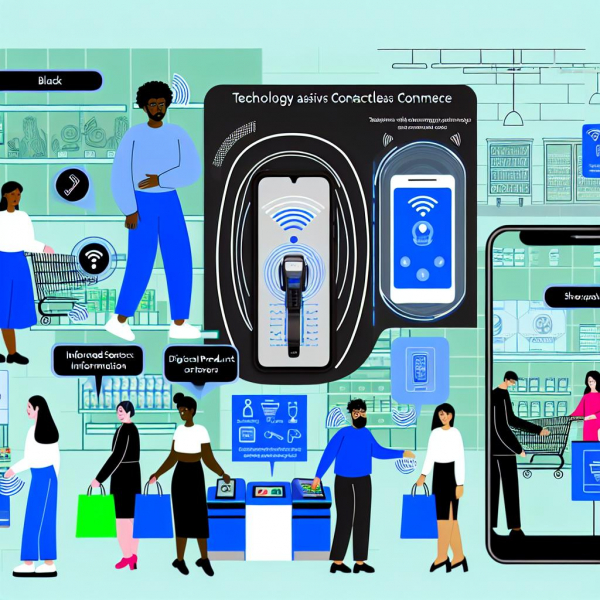In a world where technology is constantly evolving and reshaping our everyday lives, the retail industry is no exception. Imagine walking into a store, picking up your desired items, and simply walking out, with no queues, no cash, and no contact. Sounds like a scene from a futuristic movie, right? Well, welcome to the era of contactless commerce – a revolution that is not just knocking on the door of the retail industry, but has already stepped in, making itself comfortable. This seamless, frictionless shopping experience is not a distant dream anymore, but the imminent future of retail. So, buckle up as we embark on a journey to explore this fascinating realm where technology meets commerce, transforming the way we shop.
Table of Contents
- Understanding the Rise of Contactless Commerce
- The Impact of Contactless Commerce on Retail Industry
- How Contactless Commerce is Transforming Customer Experience
- The Role of Technology in Facilitating Contactless Commerce
- Challenges and Opportunities in Implementing Contactless Commerce
- Strategies for Retailers to Successfully Adopt Contactless Commerce
- The Future of Retail: Embracing the Contactless Commerce Revolution
- Q&A
- In Conclusion

Understanding the Rise of Contactless Commerce
As we navigate through the digital age, the retail industry is experiencing a significant shift towards contactless commerce. This innovative approach to shopping eliminates the need for physical interaction between the buyer and seller, making transactions smoother, faster, and more convenient. The rise of contactless commerce can be attributed to several key factors:
- Technological advancements: The proliferation of smartphones and high-speed internet has made it possible for consumers to shop from anywhere, anytime. NFC (Near Field Communication) and RFID (Radio Frequency Identification) technologies have also played a crucial role in enabling contactless payments.
- Changing consumer behavior: Today’s consumers value convenience and speed. They prefer shopping experiences that are seamless, quick, and require minimal effort. Contactless commerce caters to these preferences perfectly.
- Global events: The COVID-19 pandemic has accelerated the shift towards contactless commerce. With social distancing norms in place, consumers and businesses alike have embraced contactless transactions as a safer alternative to traditional shopping methods.
Looking ahead, contactless commerce is set to redefine the retail landscape. Businesses that adapt to this trend will not only survive but thrive in the future. Here’s a snapshot of how contactless commerce is shaping the future of retail:
| Trend | Impact on Retail |
|---|---|
| Increased use of mobile wallets | Mobile wallets like Apple Pay and Google Wallet are becoming the preferred mode of payment, reducing the need for cash transactions. |
| Adoption of voice commerce | With the rise of smart speakers, consumers are increasingly using voice commands to shop, making the shopping experience even more convenient. |
| Use of AR/VR in shopping | Augmented Reality (AR) and Virtual Reality (VR) technologies are being used to provide immersive shopping experiences, allowing consumers to try products virtually before buying. |

The Impact of Contactless Commerce on Retail Industry
The advent of contactless commerce has revolutionized the retail industry, offering a seamless and efficient shopping experience for consumers. The shift towards this technology-driven approach has been accelerated by the global pandemic, which has necessitated the need for minimal physical contact and social distancing. Contactless commerce encompasses a wide range of technologies such as mobile payments, QR codes, and NFC-enabled devices, which allow customers to make purchases without the need for physical cards or cash.
One of the significant impacts of contactless commerce on the retail industry is the enhancement of customer experience. With the ability to make purchases quickly and conveniently, customers are more likely to return, thereby increasing customer loyalty and retention. Additionally, contactless commerce also offers the advantage of improved operational efficiency. By eliminating the need for manual cash handling and card processing, retailers can streamline their operations and reduce the risk of errors.
- Increased Sales: Contactless commerce can lead to increased sales as it offers a faster and more convenient shopping experience. This can result in more impulse purchases and higher average transaction values.
- Improved Customer Data: Contactless transactions can provide retailers with valuable data about customer shopping habits, which can be used to personalize marketing efforts and improve customer service.
- Reduced Operating Costs: By eliminating the need for cash handling and card processing, retailers can reduce their operating costs.
| Technology | Impact on Retail Industry |
|---|---|
| Mobile Payments | Increased sales, improved customer data |
| QR Codes | Enhanced customer experience, reduced operating costs |
| NFC-enabled Devices | Streamlined operations, increased customer loyalty |

How Contactless Commerce is Transforming Customer Experience
As we navigate through the digital age, the retail industry is witnessing a significant shift in the way customers shop. Contactless commerce is rapidly becoming the new norm, offering a seamless and safe shopping experience. This innovative approach to retail is not only convenient but also enhances the overall customer experience by reducing wait times, eliminating the need for physical contact, and providing a more personalized shopping journey.
There are several ways in which contactless commerce is revolutionizing the retail industry:
- Mobile Payments: With the rise of digital wallets like Apple Pay and Google Wallet, customers can now make purchases with just a tap of their phone. This eliminates the need for cash or cards, making transactions faster and more efficient.
- Click and Collect: This service allows customers to shop online and pick up their purchases in-store or at a designated pick-up point. This not only saves time but also provides a safer shopping experience during the pandemic.
- Virtual Fitting Rooms: Augmented reality (AR) technology is being used to create virtual fitting rooms, allowing customers to try on clothes virtually from the comfort of their homes.
| Technology | Benefit |
|---|---|
| Mobile Payments | Fast and efficient transactions |
| Click and Collect | Safe and time-saving shopping experience |
| Virtual Fitting Rooms | Convenient and personalized shopping |
As we move forward, it’s clear that contactless commerce will continue to shape the future of retail. By embracing this trend, retailers can provide a superior customer experience, drive customer loyalty, and stay ahead in the competitive retail landscape.

The Role of Technology in Facilitating Contactless Commerce
As we navigate the new normal, the retail industry is undergoing a seismic shift, with contactless commerce emerging as the future. This transformation is largely driven by technology, which is playing a pivotal role in facilitating seamless and safe shopping experiences. From mobile payments and digital wallets to AI-powered chatbots and augmented reality, technology is reshaping the retail landscape, making it more convenient, personalized, and contactless.
One of the key technologies driving contactless commerce is mobile payments. With the rise of digital wallets like Apple Pay, Google Pay, and Samsung Pay, consumers can now make purchases with just a tap of their smartphones. This not only eliminates the need for physical cash or cards but also speeds up the checkout process. Here’s a simple table illustrating the growth of mobile payments:
| Year | Number of Mobile Payment Users (in billions) |
|---|---|
| 2018 | 0.5 |
| 2019 | 0.7 |
| 2020 | 0.9 |
| 2021 | 1.2 |
Another technology that’s making waves in the retail industry is augmented reality (AR). AR allows consumers to virtually try on products or visualize them in their own space before making a purchase. This not only enhances the shopping experience but also reduces the likelihood of returns. Brands like IKEA, Sephora, and Warby Parker are already leveraging AR to offer immersive shopping experiences to their customers.
- AI-powered chatbots are also playing a crucial role in facilitating contactless commerce. They provide instant customer service, handle inquiries, and even assist in product selection, making shopping more convenient and personalized.
- Lastly, contactless delivery options such as curbside pickup and drone deliveries are gaining popularity, ensuring that customers can receive their purchases without any physical contact.
In conclusion, technology is not just facilitating contactless commerce, it’s redefining it. As we move forward, we can expect to see even more innovative tech-driven solutions that will further enhance the contactless shopping experience.
Challenges and Opportunities in Implementing Contactless Commerce
As we navigate the new normal, the retail industry is witnessing a significant shift towards contactless commerce. This transition, while promising, is not without its challenges. The first hurdle is the need for a robust digital infrastructure. Retailers must invest in advanced technologies such as AI, IoT, and cloud computing to facilitate seamless contactless transactions. Additionally, they must ensure the security of these transactions to gain customer trust. This involves implementing stringent data protection measures and complying with privacy regulations.
Despite these challenges, the move towards contactless commerce presents numerous opportunities. For one, it allows retailers to reach a wider audience, transcending geographical boundaries. It also enables them to gather valuable customer data, which can be leveraged to personalize shopping experiences and boost customer loyalty. Furthermore, contactless commerce can lead to operational efficiency by automating routine tasks and reducing manual errors.
| Challenges | Opportunities |
|---|---|
| Need for robust digital infrastructure | Reach a wider audience |
| Ensuring transaction security | Personalize shopping experiences |
| Compliance with privacy regulations | Operational efficiency |
- AI, IoT, and cloud computing: These technologies are crucial for facilitating seamless contactless transactions.
- Data protection measures: Retailers must implement stringent measures to secure transactions and gain customer trust.
- Personalized shopping experiences: Contactless commerce allows retailers to gather valuable customer data, which can be used to personalize shopping experiences.
- Operational efficiency: Automation of routine tasks and reduction of manual errors can lead to increased operational efficiency.
Strategies for Retailers to Successfully Adopt Contactless Commerce
As we navigate through the digital age, the retail industry is witnessing a significant shift towards contactless commerce. This trend, accelerated by the global pandemic, is not just a temporary solution but a long-term strategy that offers convenience, safety, and efficiency. Retailers who wish to stay competitive must adapt to this change and implement strategies to successfully adopt contactless commerce.
One of the key strategies is to invest in technology. This includes contactless payment systems, mobile apps, and self-service kiosks. Retailers should also consider integrating their online and offline channels to provide a seamless shopping experience. This can be achieved through omnichannel retailing, which allows customers to shop across multiple platforms and pick up or return items in-store or online.
- Training staff to handle new technologies and processes is another crucial step. This will ensure a smooth transition and help prevent any potential disruptions to the business.
- Furthermore, retailers should communicate effectively with their customers about the changes. This can be done through various channels such as social media, email newsletters, and in-store signage.
- Lastly, retailers should monitor and evaluate the effectiveness of their contactless commerce strategies. This will allow them to make necessary adjustments and improvements.
| Strategy | Benefits |
|---|---|
| Invest in Technology | Enhances shopping experience, increases efficiency |
| Training Staff | Ensures smooth transition, prevents disruptions |
| Effective Communication | Keeps customers informed, builds trust |
| Monitor and Evaluate | Allows for improvements, ensures effectiveness |
Adopting contactless commerce is not just about implementing new technologies, but also about changing the way retailers operate and interact with their customers. By adopting these strategies, retailers can successfully transition to contactless commerce and stay ahead in the competitive retail industry.
The Future of Retail: Embracing the Contactless Commerce Revolution
As we step into the future, the retail industry is undergoing a significant transformation. The advent of contactless commerce is revolutionizing the way we shop, making it more convenient, safe, and efficient. This new era of shopping is characterized by the use of advanced technologies such as mobile payments, digital wallets, and contactless cards, which eliminate the need for physical contact during transactions.
There are several benefits of embracing contactless commerce. Firstly, it offers a seamless shopping experience to customers. They can make purchases anytime, anywhere, without having to wait in long queues. Secondly, it enhances the safety of transactions by reducing the risk of theft and fraud. Lastly, it provides retailers with valuable insights into customer behavior, which can be used to improve their services and increase sales.
- Mobile Payments: With the rise of smartphones, mobile payments have become increasingly popular. They allow customers to pay for their purchases using their mobile devices, without the need for cash or cards.
- Digital Wallets: Digital wallets are another form of contactless payment. They store the user’s payment information securely and allow them to make transactions with a single click.
- Contactless Cards: Contactless cards use Near Field Communication (NFC) technology to make secure payments. The customer simply has to tap their card on the payment terminal to complete the transaction.
| Technology | Benefits |
|---|---|
| Mobile Payments | Convenience, Speed, Security |
| Digital Wallets | One-click Transactions, Enhanced Security |
| Contactless Cards | Quick Payments, Reduced Risk of Theft |
In conclusion, the future of retail lies in contactless commerce. By embracing this revolution, retailers can provide a better shopping experience to their customers, enhance the security of transactions, and gain valuable insights into customer behavior.
Q&A
Q: What is contactless commerce?
A: Contactless commerce refers to the method of conducting business transactions that require no physical contact. This includes online shopping, mobile payments, and the use of digital wallets, among other things.
Q: Why is contactless commerce considered the future of retail?
A: Contactless commerce is considered the future of retail due to its convenience, speed, and safety. It allows customers to make purchases anytime, anywhere, and reduces the risk of physical contact, which is particularly important in the context of the COVID-19 pandemic.
Q: How does contactless commerce benefit consumers?
A: Contactless commerce offers consumers a seamless and convenient shopping experience. It eliminates the need to carry cash or cards, reduces waiting times at checkout, and allows for easy tracking of expenses. Plus, it offers a safer shopping experience in the current health climate.
Q: How does contactless commerce benefit retailers?
A: For retailers, contactless commerce can lead to increased sales, as it makes shopping easier and more convenient for customers. It also reduces the risk of cash handling and card fraud, and can provide valuable data on customer shopping habits, which can be used to improve services and marketing strategies.
Q: What are some examples of contactless commerce technologies?
A: Examples of contactless commerce technologies include mobile payment apps like Apple Pay and Google Wallet, digital wallets like PayPal, and contactless cards. Other examples include online shopping platforms and self-checkout kiosks in physical stores.
Q: Are there any downsides to contactless commerce?
A: While contactless commerce offers many benefits, it also has potential downsides. These include the risk of cybercrime, such as hacking and identity theft, and the potential for technology failures. Additionally, not all consumers are comfortable with or have access to the necessary technology.
Q: How can retailers prepare for the shift towards contactless commerce?
A: Retailers can prepare for the shift towards contactless commerce by investing in the necessary technology and training staff to use it. They should also ensure they have robust cybersecurity measures in place to protect customer data. Additionally, they can educate customers about the benefits of contactless commerce and how to use it.
Q: Is contactless commerce only relevant for big businesses?
A: No, contactless commerce is relevant for businesses of all sizes. Even small, local businesses can benefit from offering contactless payment options or selling products online. In fact, in the current climate, it can be a lifeline for small businesses that are unable to open their physical stores.
In Conclusion
As we bid adieu to this exploration of the future of retail, we leave you with a vision of a world where shopping is as simple as a wave of your hand, a blink of your eye, or a whisper to your smart device. Contactless commerce, with its seamless blend of technology and convenience, is not just knocking on the door of the retail industry, it’s already sauntered in, making itself comfortable. It’s a brave new world where the physical and digital realms intertwine, creating a shopping experience that’s efficient, safe, and personalized. So, as we step into this future, let’s embrace the change, let’s embrace the contactless. After all, the future of retail isn’t just about selling products, it’s about creating experiences, and contactless commerce is leading the charge.
